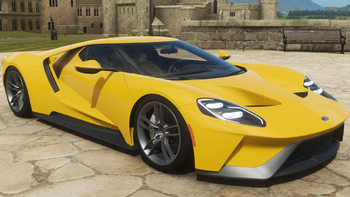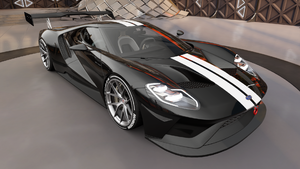Ford GT (GEN2)
| Ford GT [GEN2] | |

| |
| Car information | |
| Model Family | Ford GT |
| Year | 2017 |
| Make | Ford |
| Origin | United States of America |
| Type | Limited Production |
| Engine | 3.5 L Twin-Turbocharged V6 (Ford EcoBoost D35) |
| Power | 647 hp (482 kW) |
| Torque | 550 ft⋅lb (746 N·m) |
| Weight | 3,148 lb (1,428 kg) |
| Layout | Mid-Engine, RWD |
| Front Distr. | 43% |
| Transmission | 7-speed Paddle Shift |
| Related | Ford GT (GEN1) (Predecessor) Ford GT Horizon Edition (Horizon Edition) Ford GT Forza Edition (Forza Edition) |
The Ford GT [GEN2] (leaderboard names: 2017 Ford GT and Ford GT '17) is a mid-engined supercar produced by Ford since 2016.
The second-generation Ford GT succeeds the first-generation Ford GT produced between 2005 and 2006, and was created to celebrate 50 years since Ford's historical victory against Ferrari at the 1966 24 Hours of Le Mans.
Overview[edit | edit source]
The GEN2 Ford GT succeeds the GEN1 Ford GT as Ford's current flagship supercar, with the Ferrari 458 Speciale, Dodge Viper ACR, Chevrolet Corvette ZR1 (C7), Lamborghini Aventador LP 750-4 SV, and McLaren 675LT as its main competitors.
Production of the GEN2 Ford GT began in December 2016, with a planned production rate of one car per day at Ford's new, low-volume assembly facility at Multimatic in Markham, Ontario, Canada until October 2020.[1] The cars produced for the 2017 and 2018 model years are reserved for selected buyers, the cars produced for the 2019 model year are for buyers who passed over in the initial selection process, and the cars produced for the 2020 model year are for normal customers.[2]
Design / Chassis[edit | edit source]
The GEN2 Ford GT was constructed with a lightweight carbon fiber chassis due to Ford's aim to make the GT have "one of the best power-to-weight ratios of any production car", although it is outclassed by the likes of the McLaren 720S, McLaren Senna, and Pagani Huayra BC in that aspect. Underpinning the GT is a carbon fibermonocoque bolted to aluminum front and rear subframes covered in carbon fiber body panels. The car also has racing inspired pushrod suspension, active aerodynamics, and dihedral doors. The windshield of the vehicle is made of Gorilla Glass manufactured by Corning, which is also used for smartphone screens. Gorilla Glass is used to reduce the weight of the vehicle by allowing for a thinner windscreen with the same strength.[3]
The GT consequently weighs 3,148 lb (1,428 kg) under normal conditions, with the maximum weight being 3,354 lb (1,521 kg),[4] although its original dry weight was stated to be 2,890 lb (1,311 kg).[5]
Engine / Drivetrain[edit | edit source]
The GT is powered by a 3.5 L (3,496 cc; 213.3 cu in) twin-turbocharged EcoBoost V6 that produces 647 hp (482 KW; 656 PS) and 550 ft·lb (746 N·m) of torque.[4] Previously, this engine made 630 hp (470 KW) and 539 ft·lb (731 N·m) of torque.[5] The engine shares many components with the F-150's 3.5 L V6 engine including the cylinder heads, block, and dual fuel system. Notable differences include larger turbochargers, an aluminum intake manifold, a custom dry sumped lubrication system, unique camshafts, and higher strength rotating and timing drive components. At the time of introduction, the Ford GT had one of the highest specific power outputs of any production car.
Power is sent to the rear wheels via a seven-speed PowerShift 7DCL750 dual-clutch automatic transmission.
Performance[edit | edit source]
The GT is capable of a top speed of 216 mph (348 km/h), as well as 0 - 60 mph (97 km/h) in 2.9 seconds and 0 - 100 mph (161 km/h) in 5.5 seconds. These performance figures make it Ford's fastest production car ever.
Variants[edit | edit source]
Ford GT Horizon Edition (2017)[edit | edit source]
- Main article: Ford GT Horizon Edition
The Ford GT Horizon Edition is a special Horizon Edition variant of the GEN2 GT, made for S2 Class circuit racing. It comes with a Credits boost and an upgraded version of the Lamborghini Aventador's L539 6.5 L V12.
Ford GT Forza Edition (2017)[edit | edit source]
- Main article: Ford GT Forza Edition
The Ford GT Forza Edition is identical to the 2017 Ford GT HE minus the V12 and racing stripes. It awards a 50% Credits boost and an additional 50% Credits boost when raced on Le Mans Circuit de la Sarthe.
Ford GT Le Mans (2016)[edit | edit source]
- Main article: Ford GT Le Mans
The Ford GT Le Mans is a GTLM-class race car known for dominating the 2016 24 Hours of Le Mans.
Gameplay[edit | edit source]
Advantages[edit | edit source]
The Ford GT is aerodynamically efficient, allowing it to accelerate to 100 mph (161 km/h) more quickly than most other similar supercars. True to real life, it remains Ford's fastest car in the Forza series, with top speeds exceeding 217 mph (350 km/h). This figure is even higher in the Forza Horizon series, where it can reach 229 mph (369 km/h) at most. As a track focused supercar, it can tackle difficult cornering and braking sections with ease.
In Forza Horizon 3, the GT is actually competitive in S2 Class, as it can be upgraded for maximum speed (275 mph/443 km/h), making it a strong contender for drag races. Plus, it can be tuned to replicate the Ford GT Horizon Edition, which is more balanced in all aspects, except that the normal GT has no Credits boost.
Overall, the GT is a track focused supercar with balanced performance allowing it to take on any track.
Disadvantages[edit | edit source]
The GT does not have enough power to keep up with more powerful supercars or hypercars on straights despite its high top speed, as its acceleration gradually weakens past 186 mph (300 km/h).
In Forza Horizon 4, the GT is merely a collector's item as it cannot compete in any class it appears in due to not having any engine swaps available in that game. Because of this, it loses to the McLaren 720S and Ford Transit SuperSportVan Forza Edition, as well as many other cars in S2 Class.
Conversions[edit | edit source]
- Engine Swap
- 6.0 L V12 (Forza Motorsport 7)
- 2.6 L 4 Rotor - Racing (Forza Motorsport 7)
- 6.5 L V12 (Forza Horizon 3)
- Drivetrain
- AWD
Trivia[edit | edit source]
- The GT is featured on the cover of Forza Motorsport 6 and the main icon of Forza Motorsport 6: Apex.
- The GT appears as the US-spec model from Forza Motorsport 7 onwards.
- In this game, the GT's rear engine cover can be flung open as well, but it must be done using the "Explode" function in Forzavista.
- The GT received several new manufacturer colors in Forza Horizon 4.
- The GT's EcoBoost D35 engine, named the "V6TT", can be swapped into various Ford cars in Forza Horizon 4.
Mistakes[edit | edit source]
- Despite using the US-spec model in Forza Horizon 4, the GT wrongly retains its old Forza Motorsport 6 specifications instead of using the current updated specs that the Forza Motorsport 7 version uses.
- In addition, the rear engine cover can never be flung open in Forza Horizon 4 either.
- Its displacement is also shown in-game as 3,500 cc instead of 3,496 cc.
Miscellaneous[edit | edit source]
- The GT is named FOR_Phoenix_16 (2016 Ford Phoenix) in the internal game files. This was the car's development name.[6]
- The name "Phoenix" is derived from the mythological bird of the same name, which said to be the only one of its kind, lives for 500 years, and then dies by burning to ashes on a pyre of its own making, ignited by the sun before arising anew from the ashes. It is a reference to the Ford GT nameplate being used for the first time since the first generation GT went out of production in 2006.
Appearances[edit | edit source]
References[edit | edit source]
- ↑ Multimatic - Ford GT Deliveries Begin
- ↑ Road & Track - Ford Will Build One GT Per Day From December 2016 to October 2020, Author: Chris Perkins, Date: 10/24/2016
- ↑ Motor Trend, News - Ford GT to Use Weight-Saving Gorilla Glass Windshield, Author: Kelly Pleskot, Date: 12/16/2015
- ↑ 4.0 4.1 Motor Trend, First Tests - 2017 Ford GT First Test: The Price of Priceless, Author: Scott Evans, Date: 01/22/2018
- ↑ 5.0 5.1 Forza Motorsport 6
- ↑ The Nobeds - Forza Horizon 4 Full Car List Leaked by Windows Store, Author: Cory Johnston, Date: 06/23/2018
